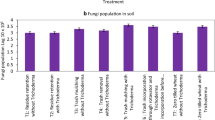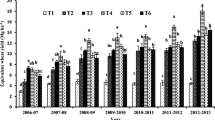Abstract
A field experiment was conducted at ICAR-IISR, Lucknow, in a split-plot design with two cropping systems and eight different crop residue management practices. In main plots, cropping systems, viz. CS1—rice–wheat (R–W) and CS2—sugarcane (plant crop)–ratoon–wheat (S–R–W) and subplots residue management practices, viz. residue removal (T1-RR); residue burning (T2-RB); residue incorporation (T3-RI); residue incorporation + Trichoderma (T4-RI + T), residue incorporation +25 % extra nitrogen application (T5-RI + N), partial residue incorporation (T6-PRI), partial residue incorporation + Trichoderma (T7-PRI + T) and partial residue incorporation +25 % extra nitrogen application (T8-PRI + N), were allocated. The observations on soil physical parameters indicated the lower mean bulk density (1.10 Mg m−3) in sugarcane–ratoon–wheat system than the rice–wheat system (1.145 Mg m−3). Increased porosity (58.68 %) was obtained in sugarcane–ratoon–wheat (S–R–W) system as compared to rice–wheat system (56.83 %). In S–R–W system, higher (19.51 %) SOC was recorded than the R–W system (16.31 Mg ha−1) at 0–15 cm depth. After harvesting of wheat in both the cropping systems, higher total carbon sequestered (@1.42 Mg ha−1) in S–R–W system than the R–W cropping system (0–15 cm soil depth). Higher contents of available nitrogen, phosphorous and potassium were recorded in S–R–W system than the R–W system after completion of crop cycle. The agronomic efficiency of rice, wheat and sugarcane crops indicated the higher level with residue incorporation along with Trichoderma application. Thus, it could be concluded that sugarcane–ratoon–wheat system acted as soil fertility restorer and crop reside management along with application of Trichoderma sustained the soil carbon level, crop productivity and agronomic/production efficiency of N for longer period.


Similar content being viewed by others
References
Beri, V., B.S. Sidhu, A.K. Bhat, B.P. Singh. 1992. Nutrient balance and soil properties as affected by management of crop residues. In Proceedings of the international symposium on nutrient management for sustained productivity vol II, ed. M.S. Bajwa, pp 133–135, PAU Ludhiana.
Blake, G.R. 1965. Bulk density. In Methods of soil analysis. Part 1. Physical and mineralogical properties, including statistics of measurement and sampling, eds. C.A. Black, D.D. Evans, L.E. Ensminger, J.L. White, F.E. Clark, and R.C. Dinauer, 374–390, 768. American Society of Agronomy, Madison, Wisconsin, USA.
Bouyoucos, G.J. 1936. Directions for making mechanical analysis of soils by the hydrometer method. Soil Science 42: 225–230.
Brady, N.C., and R.R. Weil. 1996. The nature and properties of soils, 11th ed. New York: Prentice Hall.
Cerri, C.C., M. Bernoux, C.E.P. Cerri, and C. Feller. 2004. Carbon cycling and sequestration opportunities in South America: the case of Brazil. Version of Record 20(2): 248–254.
Damodaran, V., P. Subbian, and S. Marimuthus. 2005. Effect of stubble management with biological inoculants on the growth and yield of rice (Oryza sativa) in rice based cropping systems. Acta Agronomica Hungarica 52(1): 105–108.
Das, B., D. Chakraborty, V.K. Singh, P. Aggarwal, R. Singh, B.S. Dwivedi, and R.P. Misra. 2014. Effect of integrated nutrient management practices on soil aggregate properties, its stability, and aggregate associated carbon content in an intensive rice–wheat system. Soil and Tillage Research 136: 9–18.
Dwivedi, B.S., A.K. Shukla, V.K. Singh, and R.L. Yadav. 2003. Improving nitrogen and phosphorus use efficiencies through inclusion of forage cowpea in the rice–wheat system in the Indo-Gangetic Plains of India. Field Crops Research 84: 399–418.
Ellert, B.H., and J.R. Bettany. 1995. Calculation of organic matter and nutrients stored in soils under contrasting management regimes. Canadian Journal of Soil Science 75: 529–538.
Gangwar. 2010. https://nfsm.gov.in/Presentations/FSR_Rice_22. May 2010.
Halvorson, A.D., C.A. Reul, and R.F. Follet. 1999. Nitrogen fertilization effects on soil carbon and nitrogen in a dry land cropping system. Soil Science Society of America Journal 63: 913–917.
Harman, G.E. 2000. Myth and dogmas of biocontrol changes in perceptions derived from research on Trichoderma harzianum T-22. Plant Disease 84: 377–393. doi:10.1094/PDIS.2000.84.4.377.
Hutchinson, J.J., C.A. Campbell, and R.L. Desjardins. 2007. Some perspectives on carbon sequestration in agriculture. Agricultural and Forest Meteorology 142(2–4): 288–302.
IASRI. 2015. NARS statistical package SAS. www.iasri.res.in/sscnars.
Jackson, M.L. 1958. Soil chemical analysis, 183–193. Englewood Cliffs: Prentice Hall Inc.
Jackson, M.L. 1973. Soil chemical analysis. Englewood Cliffs: Prentice Hall Inc.
Karlen, D.L., M.J. Mausbach, J.W. Doran, R.G. Cline, R.F. Harris, and G.E. Schuman. 1997. Soil quality: a concept, definition and framework for evaluation. Soil Science Society of America Journal 61: 4–10.
Kumar, S., A.S. Bangarwa, D.P. Singh, and S.B. Phogat. 1998. Dry matter accumulation in dwarf wheat varieties under different nitrogen level and sowing dates. Haryana Agricultural University Journal Research 28(4): 151–157.
Kumpawat, B.S., and S.S. Rathore. 2003. Effect of preceding grain legumes on growth, yield, nutrient content and uptake by wheat (Triticum aestivum) under different nitrogen levels. Crop Research 25(2): 209–214.
Kuo, S., and E.J. Jellum. 2002. Influence of winter cover crop and residue management on soil nitrogen availability and corn. Agronomy Journal 94: 501–508. doi:10.2134/agronj2002.0501.
Lal, R. 2006. Enhancing crop yields in the developing countries through restoration of the soil organic carbon pool in agricultural lands. Local Land Use Strategies in a Globalizing World—Managing Social and Environmental Dynamics 17(2): 197–209. (Special Issue).
Mahajan, A., R.D. Gupta. 2010. Integrated nutrient management (INM) in a sustainable rice–wheat cropping system. Springer. https://books.google.co.in/books.
McGhie, W.J., D.P. Heenan, and D. Collins. 1998. Impact of lupine, grazed or ungrazed subterranean clover, stubble retention, and lime on soil nitrogen supply and wheat nitrogen uptake, grain yields, and grain protein. Australian Journal of Agricultural Research 49(3): 487–494.
Nazirkar, R.B., and R.N. Adsule. 2002. Effect of nitrogen application through urea and FYM on yield of wheat. Journal of Maharashtra Agricultural University 27(2): 163–165.
Nelson, D.W., and L.E. Sommers. 1982. Total carbon, organic, and organic matter. In Methods of soil analysis. Part 2, ed. A.L. Page, R.H. Miller, and D.R. Keeney, 539–579. Madison: American Society of Agronomy.
Novoa, R., and R.S. Loomis. 1981. Nitrogen and plant production. Plant and Soil 58: 177–204.
Power, J.F., J.W. Doran, and W.W. Wilhelm. 1986. Crop residue effects on soil environment and dryland maize and soybean production. Soil and Tillage Research 8: 101–111.
Rao, U.A., K.M.Dakshina Murthy, T.V. Sridhar, and D. Adilaksmi. 2014. Optimization of fertilizer doses for Kharif rice, Oryza sativa L. on deltaic soils of Andhra Pradesh. International Journal of Farm Sciences 4(1): 16–20.
Razafimbelo, T., B. Barthes, M.C. Larré-Larrouy, E.F. De Luca, J.Y. Laurent, C.C. Cerri, and C. Feller. 2006. Effect of sugarcane residue management (mulching versus burning) on organic matter in a clayey oxisol from southern Brazil. Agriculture Ecosystem and Environment 115: 285–289.
Shah, K., S. Muhammad, A. Shazma, B. Jehan, and A.D. Khan. 2004. Effect of nitrogen and phosphorus application on the yield and yield components of wheat. Sarhad Journal of Agriculture 20(3): 347–353.
Sharma, S.N., and R. Prasad. 2008. Effect of crop-residue management on the production and agronomic nitrogen efficiency in a rice–wheat cropping system. Journal of Plant Nutrition and Soil Science 171(2): 295–302.
Sharma, A.K., A.K. Kelkar, O.R. Misra, S.S. Khushwaha, and A.M. Rajput. 2000. Response of wheat (Triticum durum) to integrated nutrient management under irrigated condition. Research on Crops 1(1): 105–107.
Singh, Y., and B. Singh. 2001. Efficient management of primary nutrition in the rice–wheat system. In The rice–wheat cropping systems of South Asia: efficient production management, ed. P.K. Kataki, 23–85. New York: Food Products Press.
Singh, C.B., J. Kumar, A.A. Khan, R.A. Katiyar, and A.K. Katiyar. 2002. Effect of nitrogen levels and dates J of sowing on yield and quality of wheat (Triticum aestivum L.) seeds. Progressive Agriculture 2(1): 92–93.
Singh, Y., B. Singh, and J. Timsina. 2005a. Crop residue management for nutrient cycling and improving soil productivity in rice-based cropping systems in the tropics. Advances in Agronomy 85: 269–407.
Singh, G., S.K. Jalota, and B.S. Sidhu. 2005b. Soil physical and hudraulic properties in a rice–wheat cropping system in India: effects of rice straw management. Soil Use Management 21: 17–21.
Singh, B., Y.H. Shan, S.E. Johnson-Beebout, Y. Singh, and R.J. Buresh. 2008. Crop residue management for low land rice based cropping systems in Asia. Advances in Agronomy 98: 118–119.
Singh, Y., R.K. Gupta, J. Singh, G. Singh, Gobinder Singh, and J.K. Ladha. 2010. Placement effects on rice residue decomposition and nutrient dynamics on two soil types during wheat cropping in rice–wheat system in northwestern India. Nutrient Cycling in Agro ecosystems 88: 471–480.
Shukla, S.K., R.L. Yadav, A. Suman, and P.N. Singh. 2008. Improving rhizospheric environment and sugarcane ratoon yield through bioagents amended farm yard manures in udic Ustochrept soil. Soil and Tillage Research 99: 158–168. doi:10.1016/j.still.2008.02.007.
Sisti, C.P.J., H.P. Santos, R. Kohhann, B.J.R. Alves, S. Urquiaga, and R.M. Boddey. 2004. Change in carbon and nitrogen stocks in soil under 13 years of conventional or zero tillage in southern Brazil. Soil and Tillage Research 76: 39–58.
Srinivas, A., V. Satyanarayana, and N.V. Ramaiah. 1997. Dry matter accumulation and yield of wheat Triticum aestivum L. varieties as influenced by nitrogen and zinc application. Journal of Research ANGRAU 25(4): 5–8.
Verma, T.S., and R.M. Bhagat. 1992. Impact of rice straw management practices on yield nitrogen uptake and soil properties in a wheat–rice rotation in Northern India. Fertilizer Research 33: 97–106.
Walkley, A., and I.A. Black. 1934. An examination of the Degtjareff method for determining soil organic matter and a proposed modification of the chromic acid titration method. Soil Science 37: 29–38.
Yadav, R.L., S.R. Prasad, R. Singh, and V.K. Srivastava. 1994. Recycling sugarcane trash to conserve soil organic carbon for sustaining yields of successive ratoon crops in sugarcane. Bioresource technology 41: 231–235.
Yadav, R.L., S.K. Shukla, A. Suman, and P.N. Singh. 2009. Trichoderma inoculation and trash management effects on soil microbial biomass, soil respiration, nutrient uptake and yield of ratoon sugarcane under subtropical conditions. Biology and Fertility of Soils 45: 461–468.
Yedidia, L., A.K. Srivastva, Y. Kapulnik, and I. Chet. 2001. Tricoderma hazarium on microelement concentrations and increased growth of cucumber plant. Plant and Soil 235: 235–242.
Acknowledgments
Authors are grateful to Director ICAR-Indian Institute of Sugarcane Research, Lucknow, for extending the facilities to provide research work at the Institute. Authors duly acknowledge the administrative and technical support of Viswa Bharti Shiksha Niketan, West Bengal.
Author information
Authors and Affiliations
Corresponding author
Ethics declarations
Conflict of interest
The authors declare that they do have no conflict of interest.
Rights and permissions
About this article
Cite this article
Shukla, S.K., Shee, S., Maity, S.K. et al. Soil Carbon Sequestration and Crop Yields in Rice–Wheat and Sugarcane–Ratoon–Wheat Cropping Systems Through Crop Residue Management and Inoculation of Trichoderma viride in Subtropical India. Sugar Tech 19, 347–358 (2017). https://doi.org/10.1007/s12355-016-0470-x
Received:
Accepted:
Published:
Issue Date:
DOI: https://doi.org/10.1007/s12355-016-0470-x




